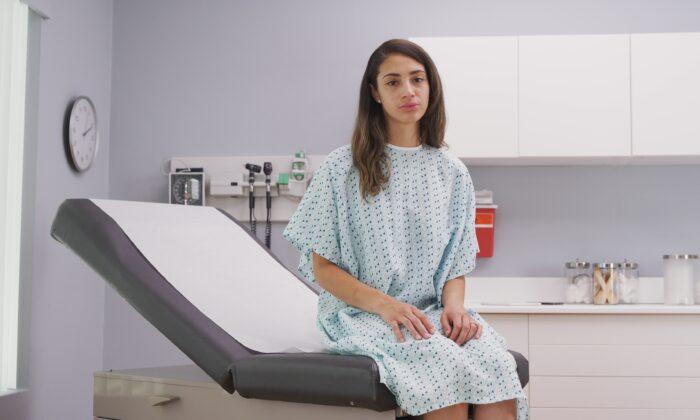After a young woman we’ll call Jane had her first pelvic exam, her doctor wrote her a prescription for birth control pills.
“What are these for?” she asked, perplexed.
“Because you’re having sex,” her doctor said.
“No I’m not,” Jane responded, turning red in the face.
“Well, you’re 23, of course you are,” her doctor insisted.
“It was physically traumatic and emotionally humiliating,” said Jane, who requested that The Epoch Times not use her real name.
Young women such as Jane who go to the gynecologist are often subjected to manual pelvic examinations as a routine part of their visits. But a pelvic exam, even when done gently, can be both painful and embarrassing. And, it turns out, at least half of these exams are being conducted without any medical indication.
According to their research, which was published in the peer-reviewed journal, JAMA Internal Medicine, half of these exams, some 1.3 million, were unnecessary.
ACOG: Invasive Exams Should Not Be Routine
Pelvic exams involve examining the outer genitalia and the perineum (the tissue between the vulva and the anus) for signs of abnormalities, including lesions, warts, cysts, and tumors.After an external examination, the doctor inserts one to two fingers of one hand inside the vagina to feel the vaginal walls and the patient’s cervix in order to check for masses or other abnormalities. At the same time, the doctor uses the other hand to palpitate the outside of the patient’s uterus.
Once part of routine well-woman care, in 2018, the American College of Obstetricians and Gynecologists (ACOG) recommended that pelvic exams only be performed when there is a medically valid reason to do so, based on an individual patient’s history or symptoms.
A Blip on the Radar
But that isn’t what’s happening, says Dr. Nathan Riley, an OB-GYN in Louisville, Kentucky, who wasn’t involved in the JAMA study. According to Riley, most gynecologists are so busy that they don’t take the time to explain to patients what their options are.“There are so many misaligned incentive structures that make it impossible for doctors to do the right thing,” Riley says. “They’ve got to see 20 patients this morning—that’s their mandate from the higher-ups—and you’re just a blip on the radar.”
Furthermore, Riley argues that doing unnecessary pelvic exams on female teenagers and young adults is a symptom of a larger problem in the way medicine is practiced in the United States.
Emotionally Traumatic
The issue isn’t just that the pelvic exam isn’t medically indicated. As anyone who has had one, including this writer, can tell you, it’s also painful, often embarrassing, and potentially harmful.“Not only is this not a necessary exam, you could actually cause some trauma for a young girl who has never had anything inside her vagina,” Riley points out.
Dr. Cornelia Franz, a pediatrician in private practice in Orlando, Florida, believes pelvic exams aren’t just anxiety-producing. Penetrating a patient’s genitals in a medical setting often feels like a violation.
Less-Invasive Options
Dr. Suzanne Gilberg-Lenz is an OB-GYN based in Beverly Hills, California, who has been practicing medicine for 20 years. Gilberg-Lenz says there are less-invasive ways to check young women for cancer and other gynecological health problems.“There aren’t that many medical reasons to do a pelvic exam,” Gilberg-Lenz says, adding that she doesn’t recommend these exams for anyone under 21 who isn’t sexually active. A pelvic exam also need not be a given for adults who are. If one of her patients has concerning symptoms, Gilberg-Lenz usually suggests starting with an ultrasound, which is non-invasive and available at her office.
But the important thing, Gilberg-Lenz says, is that these decisions are made as a team.
“Your first experience with gynecological care needs to be a positive, affirming experience where there is shared decision making,” Gilberg-Lenz says.
That is the approach that Franz uses as well. Too often, however, she notes that that isn’t the case among those in her profession.
Ask for a Pause
So what do you do if you are a young woman going to the gynecologist for the first time or the parent of a teen or young adult who needs gynecological care? Riley advises his patients to learn about their right to informed consent. Your doctor should be taking the time to explain the benefits and risks of every recommended procedure, he says. And, Riley insists, you always have the right to ask for clarification and to refuse treatment if you feel uncomfortable.“Just asking for a pause is critical,” Riley says. “It forces the physician to explain to you in their words why they want to do an exam. And if they can’t verbalize their reasons and answer your questions, you can say: ‘It doesn’t sound like there’s much benefit to doing this. I think I’ll pass.’”
Franz similarly counsels her teenage patients (and their parents) that they have the right to say no if a doctor recommend something that feels unnecessary or makes them uncomfortable: “What do you tell your four-year-old if somebody wants to touch their privates? You teach her to say no! Well, I tell my patients that: You have the right to say no.”
Franz also talks directly to her patients about gynecological exams so they know what to expect. And both Riley and Franz say that you as the patient—at any age—should insist that the doctor explain the procedure beforehand, and talk about what they are doing as it is happening.






